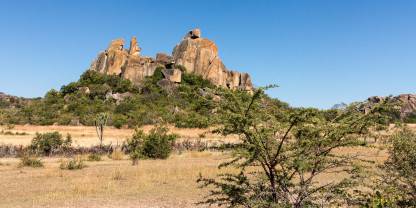Average Expert Rating
Rating Breakdown
Write a User ReviewIconographic Zimbabwean Scenery With Its Stunning Kopjes
More than just a wonderful scenic spot or a wildlife refuge, Matobo National Park is one of the cultural highlights of Zimbabwe. It should in fact be considered one of the world’s ‘power places’ – right up there alongside Great Zimbabwe Ruins as an African counterpart to Machu Picchu and Angkor Wat! Trek in Matobo and you will see great troops of baboons (and perhaps the leopards that feed on them). Fantastic eagle sightings await, too. But there are also ancient lookouts and fortifications, and the storage areas and forges where the warriors of Lobengula once made their fearsome assegais. In this park lies not only the ancient ‘Rain Shrine’ of the Ndebele but also the grave of Cecil Rhodes, who asked to be buried here on what he called ‘the view of the world’. Rhodes was a realist – I guess he figured that if he was going to have to spend eternity in one spot, he might as well give himself something interesting to look at!
Lost in a Lonely World of Granite
Read more
one stronghold for these magnificent raptors, with a current population of around 200 breeding pairs.Ancient Hills in the Heart of Matabeleland
I felt a strong spiritual presence when visiting the dwalas, or eroded granite kopjes, of the Matopos. Many others, apparently, feel the same; some of the dwalas appear precariously balanced, as if held in place by supernatural forces, and the rock art that adorns their caves hints at age-old secrets. Coloured grey, pink, ochre and gold by swathes of lichen, there’s an appealing, sculptural quality to the formations. I scrambled up a couple of them to admire the view of the surrounding bushland, which has been stocked with white rhinos – rangers will take you out on a tracking expedition on request.
The park was very quiet when I visited – it was just me, my guide and a couple of soaring eagles – but for me, that only added to the atmosphere.
Granite Whalebacks and Invisible Leopards
He wasn’t wrong.
The smooth granite hills that typify Matobo are easy to walk upon, and the scenery is to die for (especially if one gets too close to some of the precipitous drop-offs). Impossibly poised boulders, some as large as houses, sit like ill-balanced eggs atop rounded domes, which are, in turn, surrounded by grasslands and forests. The larger specimens are known as whalebacks because, well, they look like pods of whales arching out of a sea of trees.
My wife and I sat upon one of these, beneath the shadow of a huge split boulder, and watched the African sun disappear below a horizon cluttered with bizarre and wonderful rock formations. A big troop of baboons were going berserk on the dome opposite us, probably because they had seen a leopard on the prowl, but alas, even
Read more
though Matobo is reputed to have one of the largest densities of these cats in all of Africa, they are seldom observed by people. I’ve been to this park numerous times, and the most I’ve seen of them are their footprints and scats.Although the leopards might well be elusive, the grand scenery of Matobo is always on full display. Be it the numerous geological formations (some of which sport ancient rock paintings) or the lovely lakes and forests, you’ll be hard-pressed to find anywhere else quite so beautiful in all of Zimbabwe.
Wildlife can be a bit thin on the ground. There is a specially guarded section of the park where rhinos can be seen, but you won't encounter lions or elephants at all.
Birding is great though, and you’ll also have the opportunity to spot common game such as zebra, kudu and eland. Klipspringers and rock hyrax are two a penny.
Cecil John Rhodes (after which Rhodesia, now Zimbabwe, was named) is buried on a prominent lookout atop one of the largest hills of Matobo. Even if you don’t feel like paying homage to such a divisive colonial figure, the views alone make it well worth the climb.

